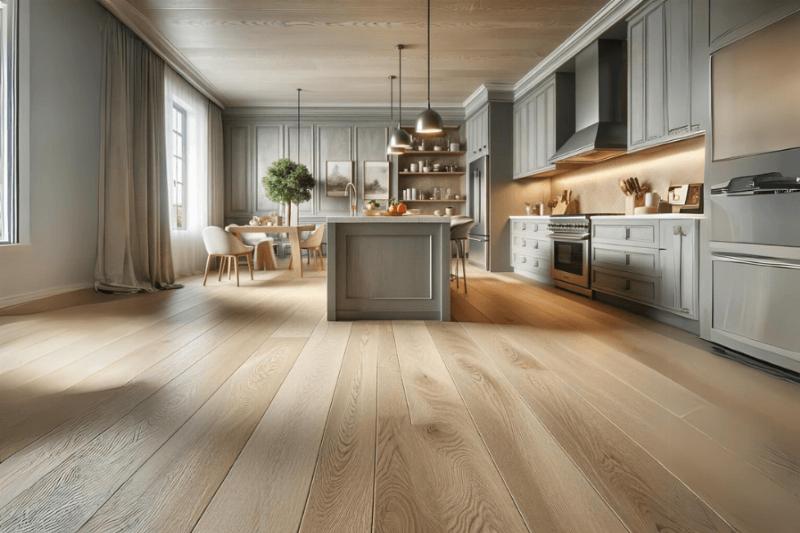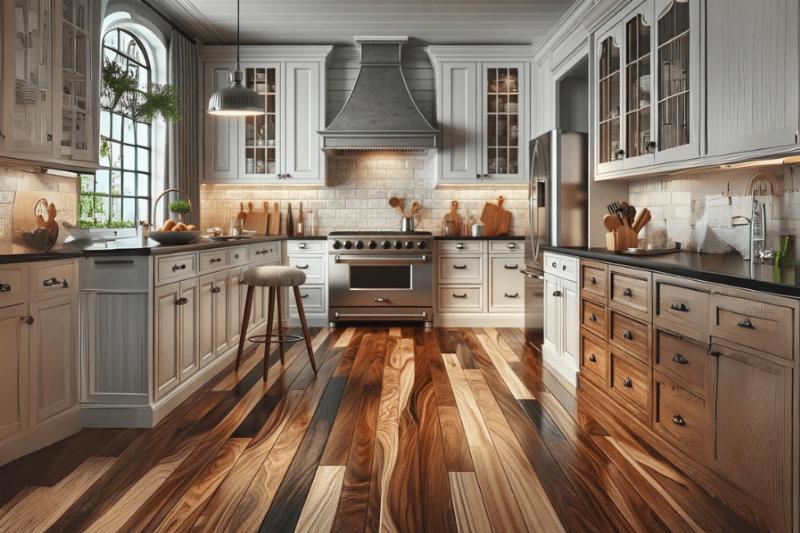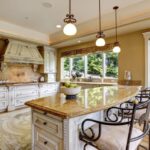Your kitchen is a busy place, so its flooring needs to be both practical and durable. But that doesn’t mean you have to give up on having a stylish kitchen. Think about your budget, your lifestyle, and the look you want, and wooden floors are the perfect choice for a kitchen makeover.
In this guide, we will explore all the essential aspects of wooden flooring for kitchens, providing you with comprehensive insights to help you make an informed decision. So, stay tuned!
The Appeal of Wood Floors in Kitchens
Wood floors in the kitchen are more than just a functional surface. They are a vital element in the overall design and atmosphere of your home.
Aesthetic Value
The variety of wood available for flooring is vast. Each one has its unique charm. Classic choices like oak provide a traditional, warm look. It has an attractive grain pattern. On the other hand, exotic woods like teak offer a unique, rich color palette and distinctive grain patterns. Teak is highly valued for its exceptional hardness and moisture resistance.
Beyond their visual appeal, wood floors add a sense of warmth and comfort to a kitchen. Unlike tile or concrete, wood has a natural, tactile quality that feels warm underfoot.
Practical Benefits
Wood flooring in the kitchen is not just about aesthetics; it also offers several practical benefits:
- High-quality wood floors are incredibly durable and can last for decades, even in high-traffic environments.
- Homes with wood flooring, especially in critical areas like the kitchen, often command a higher resale value.
- When compared to other flooring options like tile or vinyl, wood floors offer a unique combination of durability and comfort.
- Additionally, wood expands and contracts with changes in humidity. This makes it well-suited for varying kitchen conditions.
Choosing the Right Wood for Your Kitchen

The type of wood you choose for your kitchen floor will significantly influence both its aesthetic appeal and functionality.
There are two types of wood: hardwood and softwood. Hardwoods, such as oak, maple, and cherry, are typically more durable and better suited for high-traffic areas like kitchens. They are denser, more scratch-resistant, and can handle daily wear and tear better than softwood.
Softwoods, like pine or cedar, are generally less expensive but are more prone to dents and scratches. So, they are less ideal for a busy kitchen environment.
Popular Choices in Wood Flooring
Here, we will explore popular wood flooring options that people prefer in 2024.
1. Maple Wood Flooring
Maple wood flooring is a strong and stylish choice for your floors. It is among the sturdier wood species used for flooring and offers resilience against heavy foot traffic. Its grain pattern is characterized by a subtle, straight layout, occasionally embellished with swirls and waves.
The colour palette of natural maple flooring ranges from creamy white to a pale reddish-brown, with the potential for a slight yellowing over time.
Pros
- It is highly durable and capable of withstanding heavy foot traffic.
- The subtle grain pattern and light color of maple provide a versatile backdrop for various interior styles.
- Maple is less porous than some other wood species.
Cons
- The natural color of maple flooring may be slightly yellow over time, which could impact the appearance of the floor.
- Due to its density, maple can be challenging to stain evenly.
- Maple flooring is often more expensive than specific alternatives like pine.
2. Pine Wood Flooring
Pine Wood Flooring is an excellent choice for those who want a cozy and rustic feel in their homes. But what makes pine charming are its knots and grain patterns, giving it a rustic look. It comes in colors from light yellow to rich golden, bringing warmth to your home.
Pros
- Pine is generally more affordable than many hardwood options, providing a budget-friendly choice.
- Due to its softer nature, pine wood is more accessible to cut and install. So, it is a favorable option for DIY projects.
- Pine has a rich history as a traditional flooring material, particularly in older homes and historical buildings.
- Pine grows relatively quickly, making it more sustainable and environmentally friendly.
Cons
- Being a softwood, pine is more prone to scratches and dents.
- Regular maintenance, including sweeping, vacuuming, and occasional damp mopping, is necessary.
- Pine is more susceptible to damage from heavy furniture, sharp objects, and high-heeled shoes.
3. Hickory Wood Flooring
Hickory wood flooring is a standout choice known for its impressive strength, eye-catching grain patterns, and rustic charm: this hardwood is one of the most challenging domestic options for flooring. Hickory’s distinctive grain patterns and colour variations go from light cream to medium brown, with dark streaks making a strong contrast. This mix gives the floor a unique rustic look.
Pros
- Hickory is one of the most challenging domestic woods, providing exceptional durability and resistance to dents, scratches, and wear.
- Each hickory floor is distinct, showcasing its own patterns and color variations. So be happy that no two floors are exactly alike.
- Hickory’s rustic charm is versatile, complementing various interior designs.
Cons
- Due to its hardness, hickory can be challenging to cut and install.
- Hickory is generally more expensive than some common hardwoods like oak or maple.
Finishes and Treatments for Kitchen Wood Flooring

Selecting the right finish for your kitchen wood flooring is crucial. Not only does it protect the wood and extend its life, but it also plays a significant role in the floor’s overall appearance. Here’s a detailed look at the types of finishes available.
1. Polyurethane
This is a popular choice for kitchen wood floors due to its durability and ease of maintenance. Polyurethane finishes come in two types:
- Water-Based Polyurethane: Offers a clear finish that retains the wood’s natural color, dries quickly, and has a low odor. It’s not as durable as oil-based polyurethane but is easier to apply.
- Oil-Based Polyurethane: Provides a more durable finish with a slight amber tint. It takes longer to dry and has a more pungent odor during application.
2. Wax
Traditional wax finishes create a natural, low-sheen look. They are less durable than polyurethane but can be easily touched up. Wax finishes require more frequent reapplication and are not as resistant to water and stains.
3. Oil Finishes
These penetrate the wood to protect it from the inside. Oil finishes bring out the richness of the wood’s natural grain and offer a more traditional, matte look. However, they are less resistant to spills and require more maintenance.
4. Matte Finishes
These finishes are gaining popularity for their modern, understated look. A matte finish helps hide minor scratches and imperfections. It also reduces glare, which can be beneficial in brightly lit or sun-filled kitchens.
5. Glossy Finishes
High-gloss finishes offer a sleek, refined look. They reflect light, which can help brighten the kitchen and make the space appear larger. However, they tend to show scratches, dust, and footprints more easily than matte finishes.
Is Wood Flooring Ideal for Your Kitchens?
Wood flooring is a good choice for kitchens, although the suitability can vary depending on the type of wood and its construction. We’ve consulted experts to gather insights on various wood flooring options for kitchens. If you’re drawn to the idea of a solid wood floor, is it a wise decision for your kitchen?
According to David Papworth, who is the general manager of Junckers, wooden floors are a popular and sensible choice for kitchens. They provide a warm and comfortable feel underfoot. They add a touch of natural beauty that complements any kitchen style, whether it’s contemporary or traditional.
However, the suitability of wood flooring in the kitchen varies. Here are some key considerations and recommendations:
| Type of Wood Flooring | Pros | Cons |
|---|---|---|
| Solid Wood Flooring | Natural beauty and warmth. Durable and easy to clean. | Prone to water damage. Limited compatibility with underfloor heating |
| Limited compatibility with underfloor heating | Enhanced durability and stability. Suitable for kitchens and underfloor heating | Requires caution with water exposure |
| Reclaimed Wood Flooring | Sustainable with unique character. Reduces environmental impact | Resistance to spills varies with the finish |
| Wood Lookalikes (Vinyl, Laminate, Tile) | Wood-like appearance with added benefits. Easy to clean, more moisture-resistant | Varies in authenticity |
Consult a Kitchen Flooring Professional from Smart Remodeling LLC
To do flooring installation is quite a challenging task and requires professional help. Otherwise, you may end up scratching your head and later paying to fix the issues. Now, in the industry of house remodeling, people always want a reliable partner to whom they can give their demands and rest assured.
Smart Remodeling LLC is your trusted company. It is in Houston, Texas, and has been in the residential and commercial remodeling business for decades. It is the top local remodeling company that ensures the safety of its clients with the best results. You can read reviews to gain insights into the experiences of others and confidently choose Smart Remodeling LLC for your remodeling needs.
Final Wording
Wood floors in the kitchen can be an excellent choice for those who value aesthetics and comfort and are willing to commit to the maintenance they require. Selecting the right wood flooring will also enhance your home’s value. Consider the type of wood, installation methods, and maintenance requirements to ensure a successful integration into your kitchen.







